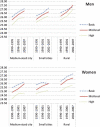The obesity epidemic slows among the middle-aged population in Sweden while the socioeconomic gap widens
- PMID: 21160918
- PMCID: PMC3002098
- DOI: 10.3402/gha.v3i0.5149
The obesity epidemic slows among the middle-aged population in Sweden while the socioeconomic gap widens
Abstract
Background: Obesity prevalence has continuously increased in Northern Sweden as elsewhere. A cohort effect has been shown and an increasing proportion of the middle-aged population is maintaining body weight.
Objective: To test the hypothesis that the obesity epidemic continues but at different speeds that are dependent on socioeconomic status.
Design: Cross-sectional (103,940 adults) and longitudinal (26,872 adults) data from the Västerbotten Intervention Program 1990-2007 were included. All adults in Västerbotten County are invited to a health examination at the ages of 40, 50, and 60 years. Body mass index (BMI) and socioeconomic status, assessed by residence location, marital status, and education were evaluated.
Results: BMI increased in all groups but was greater among men. During 1990-1995 and 2002-2007, mean BMIs were 25.9 and 26.8 among men and 25.2 and 25.9 among women. The trend of increasing BMI slowed around the year 2000 (p<0.001), but this was only observed among the highly educated adults in the most urbanized area. The difference between educational groups increased throughout the study period (men p=0.014, women p=0.002). Longitudinal data for both sexes showed a twofold higher baseline prevalence of obesity among individuals with basic compared to high education and it nearly doubled in all groups during the 10-year follow-up. Low education, living in a rural environment, and living alone were independent predictors of obesity development. The overall cumulative 10-year incidence was 9.4% in men, 9.1% in women, and twofold higher among those with basic and mid-level education who live in rural areas compared to those with high education who live in cities.
Conclusion: The trend of increasing obesity has slowed in this middle-aged Northern Sweden population, but this trend shift occurred primarily among those with high education who live in an urban environment. Greater efforts to combat obesogenic environments are needed and should take socioeconomic and sociocultural aspects into account.
Keywords: environmental impact; incidence; obesity/epidemiology; prevalence; socioeconomic status.
Figures


Comment in
-
The rate of joint replacement in osteoarthritis depends on the patient's socioeconomic status.Acta Orthop. 2016 Jun;87(3):245-51. doi: 10.3109/17453674.2016.1161451. Epub 2016 Mar 16. Acta Orthop. 2016. PMID: 26982799 Free PMC article.
References
-
- WHO. Geneva: WHO; 2000. Obesity: preventing and managing the global epidemic. Report of a WHO Consultation (WHO Technical Report Series 894) Available from: http://www.who.int/nutrition/publications/obesity/WHO_TRS_894/en/index.html [cited 25 February 2010] - PubMed
-
- Kumanyika S, Jeffery RW, Morabia A, Ritenbaugh C, Antipatis VJ. Obesity prevention: the case for action. Int J Obes Relat Metab Disord. 2002;26:425–36. - PubMed
-
- Ezzati M, Lopez AD, Rodgers A, Vander Hoorn S, Murray CJ. Selected major risk factors and global and regional burden of disease. Lancet. 2002;360:1347–60. - PubMed
-
- Peeters A, Barendregt JJ, Willekens F, Mackenbach JP, Al Mamun A, Bonneux L. Obesity in adulthood and its consequences for life expectancy: a life-table analysis. Ann Intern Med. 2003;138:24–32. - PubMed
-
- Haslam DW, James WP. Obesity. Lancet. 2005;366:1197–209. - PubMed
LinkOut - more resources
Full Text Sources
Miscellaneous
